
Fragmentary Psalters from Sinai
Maria Tomadaki
September 8, 2023
In 2022, we were fortunate to acquire digital images of twenty-two fragmentary Psalter manuscripts thanks to the kind permission of the Archbishop of Sinai Damianos and the mediation of the Mount Sinai Foundation in Athens. These fragmentary Psalters were discovered in 1975, along with other important manuscripts and fragments, in a crypt of St. Catherine's Monastery on Mount Sinai. Panagiotis Nikolopoulos, former director of the National library of Greece, described them some years later in his catalogue entitled The New Finds of Sinai.[i] My task, within the framework of the project “Die Editio critica maior des griechischen Psalters”, was to prepare more detailed descriptions of these Psalters.
Most of them are severely damaged manuscripts; for instance, many are defective at the beginning and at the end. They are all minuscule paper manuscripts with the exception of Ra 7069, which is parchment. Their dates range from the fourteenth to the sixteenth centuries, but the majority of them originate from the end of that period, as their handwriting indicates. Specifically, the Psalters Ra 1876, Ra 7072, Ra 7076, Ra 7077, Ra 7079, Ra 7080, Ra 7082, Ra 7085, Ra 7086, Ra 7087, Ra 7088, Ra 7089, Ra 7090 are dated to the fifteenth and sixteenth centuries, whereas the codices Ra 1867, Ra 7069, Ra 7071, Ra 7073, Ra 7075, Ra 7081, Ra 7083 and Ra 7084 were possibly produced during the fourteenth century.
Several of the fourteenth-century Psalters are written in intense black ink and in an elegant minuscule script, which recalls the so-called “Metochites style” (e.g., Ra 7071, Ra 7073, Ra 7075).[ii] The titles, the initials, and sometimes the punctuation signs of the Sinaitic Psalters are highlighted in bright red ink. The Psalter Ra 7083 is a case in point. It begins with a red decorated headpiece and the symbol of the cross, which, along with two epigrams, mark the apotropaic function of the Psalter. The verses of an unpublished epigram surround the cross and are accompanied by depictions of nails, which are symbols of Jesus’ passion. The speaking voice of the epigram could be identified with the scribe or the reader of the Psalter.
Σταυρῷ με ῥύσαις, Ἰησοῦ, ᾧ προσηλώθης πάθους
ἥλοις προσηλῶν, Χριστέ μου, τὴν ἐμὴν ἁμαρτίαν.
You may save me, oh Jesus, with the cross of your passion
on which you were nailed, transfixing with nails, my Christ, my own sin.
In another iambic epigram of the same leaf, the book of Psalms is personified, expressing a similar idea, namely that the Psalter frees its readers from sins:[iii]
Δαυϊτικὴ πέφυκα δέλτος ᾀσμάτων
φέρουσα τῷ γράψαντι φέρτατον κλέος,
θεόγραφον χάριν δὲ τῷ κεκτημένῳ,
λύσιν ὀφλημάτων δὲ τοῖς μελετῶσι.
I am the Davidic book of songs
bringing highest glory to the scribe,
godly-written grace to the owner,
and deliverance from sins to the readers.
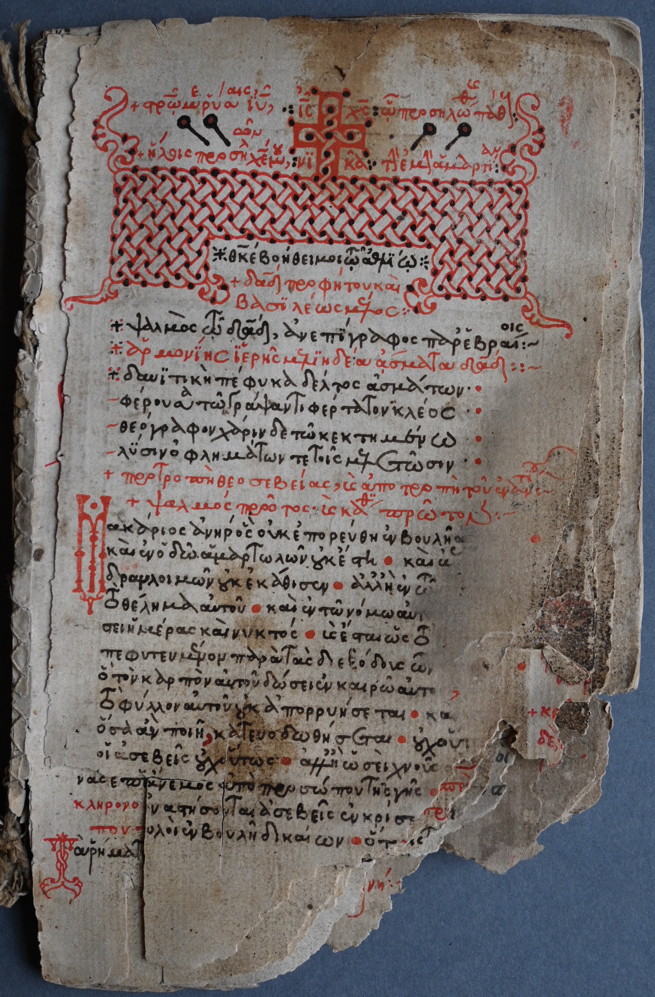
Ra 7083, f. 1r © St. Catherine's Monastery, Mt. Sinai
A special witness of the Psalms is the fragment Ra 7079. Nikolopoulos stated that this is a Psalter manuscript, but it contains prayers of repentance by the patriarch Gennadios Scholarios (ca. 1400–1473), which resemble the Psalms 42–43, 45, 55–56, 59, 61, 30, 76 and 78.[iv]
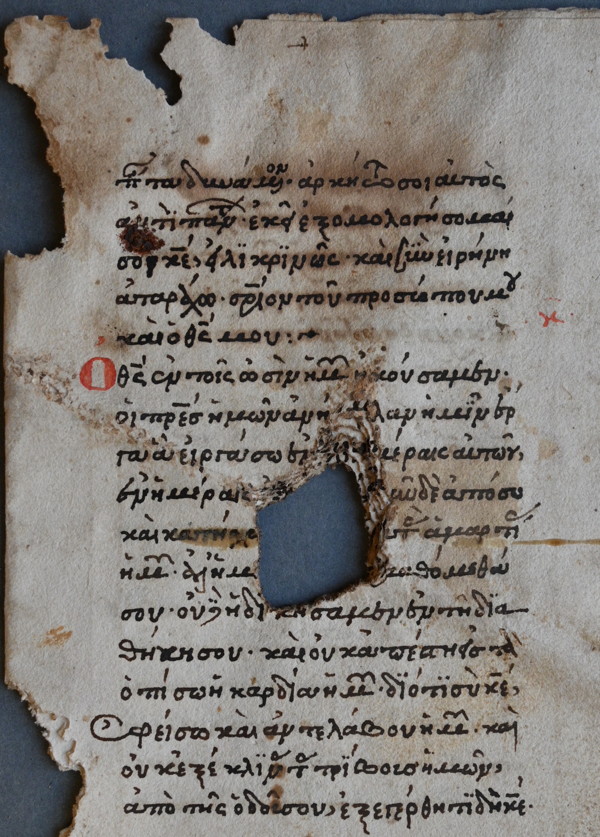
Ra 7079, f. 1r © St. Catherine's Monastery, Mt. Sinai
Another interesting fragmentary Psalter is Ra 7073, which contains the Psalms in Greek and Arabic. It could have been used as a prayer book by Arabic-speaking monks or for serving the needs of bilingual worship services. To my knowledge, this is the only fourteenth-century Psalter in Greek and Arabic, which is currently kept at St. Catherine's Monastery. The other Greek and Arabic Psalters from Sinai are older and are written in a different script and style: Ra 1191, Ra 1192, and Ra 1193.[v]
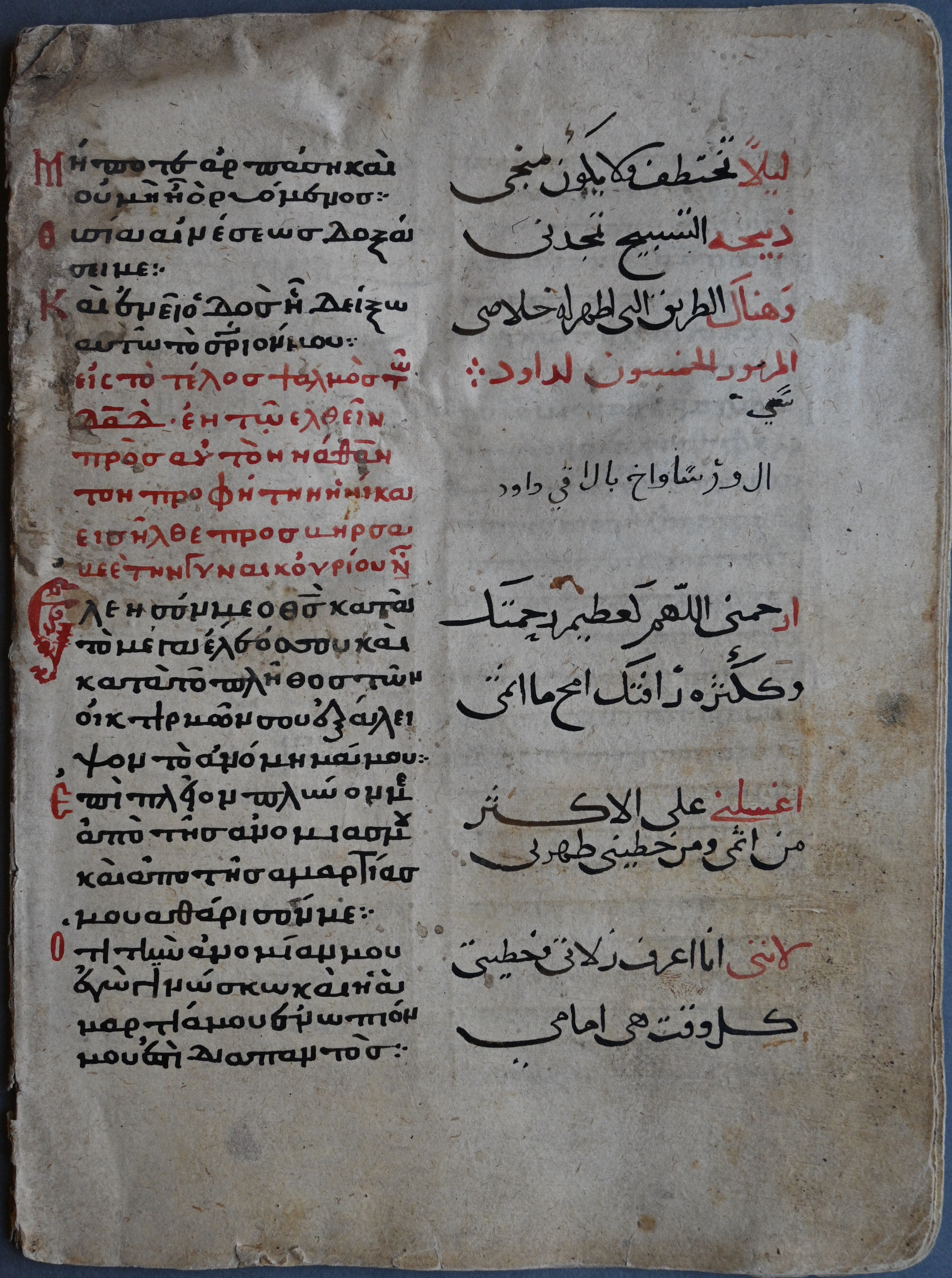
Ra 7073, © St. Catherine's Monastery, Mt. Sinai
A detailed comparison between the fragmentary Psalters and the Sinaitic Psalters published online by the Library of Congress, showed that two of the fragments derive from known Sinaitic Psalter manuscripts. In particular, I was able to make the following two identifications of fragments.
1. The fragment New Finds X 15 originates from the codex Sinait. gr. 125; both are described for our online catalogue under the Rahlfs number 1867. 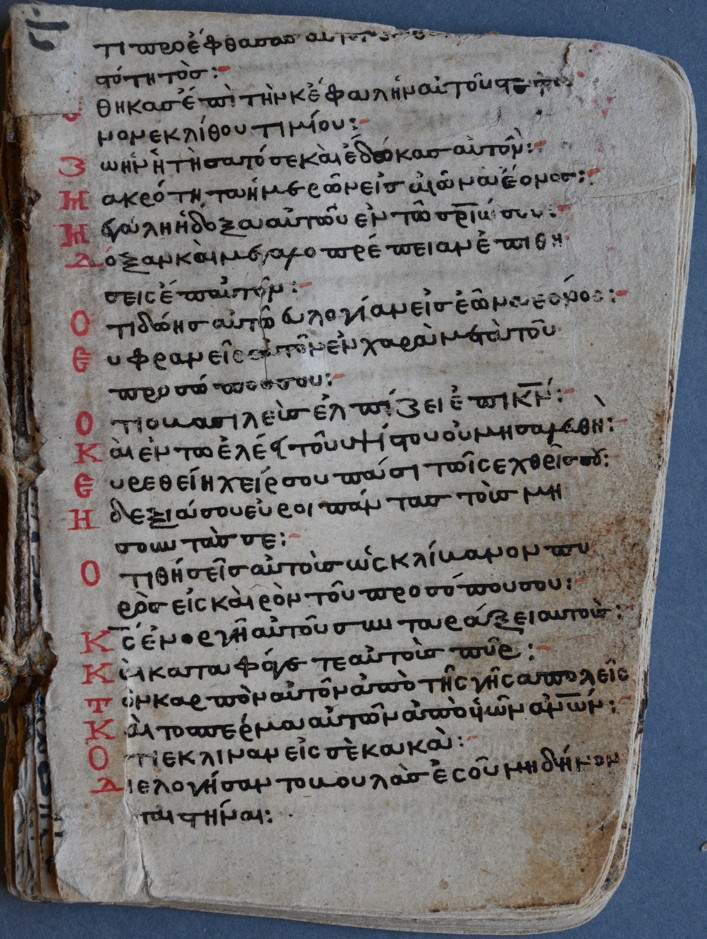
Ra 1867, f. 1r © St. Catherine's Monastery, Mt. Sinai
2. The fragment New Finds, X 80 once belonged to the codex Sinait. gr. 134; they are currently described under the Rahlfs number 1876.
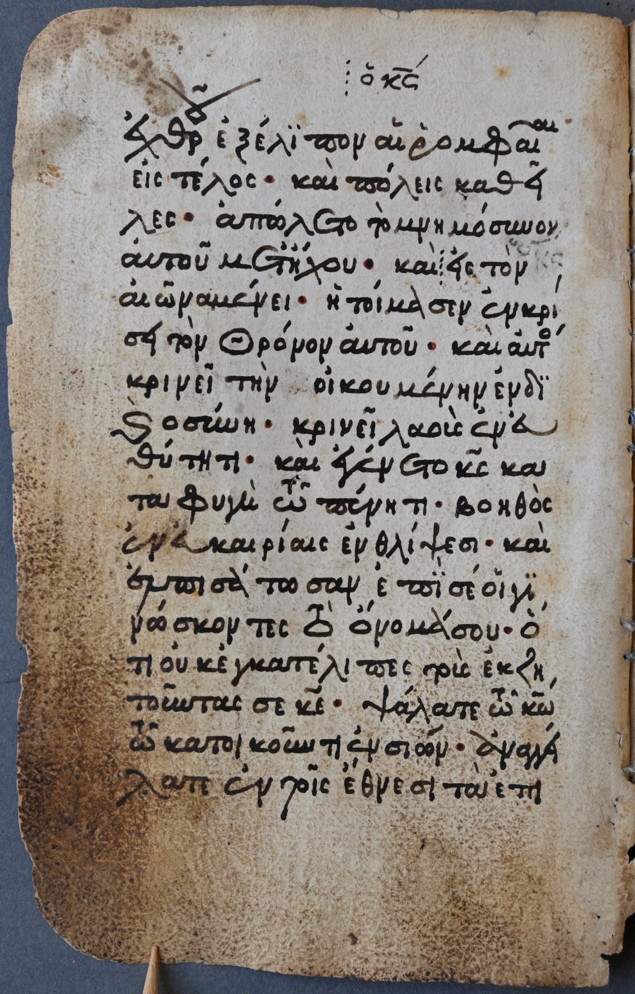
Ra 1876, f. 1v © St. Catherine's Monastery, Mt. Sinai
Τhe palaeographical examination of this group of manuscripts also revealed that the codex Ra 7081 was possibly written by the same scribe as the fourteenth-century Psalters, Ra 1839 and Ra 1873, which contain half of the verses in each Psalm and Ode and were particularly used at St. Catherine's Monastery for antiphonal psalmody.
It is difficult to fully explore and identify the textual tradition of these fragmentary Psalters, because they do not preserve exactly the same Psalms and a detailed collation of them all is impossible. The collation of Psalm 82 from fragments Ra 1867, Ra 1876, Ra 7073, Ra 7075, Ra 7083 revealed that these preserve common divergent readings from Alfred Rahlfs’ edition of the Psalms, which are close to the L-group of manuscripts.[vi] Rahlfs relates this group to the recension of the Psalms prepared by Lucian of Antioch (d. 312).[vii] It is noteworthy that most of these readings are not transmitted in the famous codex Sinaiticus (Ra S) or in the codices Ra 1070, Ra 1185, Ra 1186, Ra 1188, Ra 1189, Ra 1191, Ra 1190, Ra 1192, which are some of the oldest Psalter manuscripts from Sinai.[viii] This could be an indication that the text of the Psalm 82 did not remain entirely stable through the centuries in this particular geographical area.
Nikolopoulos and the first scholars who studied the New Finds, faced the huge task of cataloguing and identifying numerous newly discovered manuscripts and fragments.[ix] Although they did an admirable job under difficult circumstances in Sinai, more work is needed by the new generation of scholars in order to fully explore the manuscript treasure of Saint Catherine’s Monastery.
[i] P. Nikolopoulos, Holy Monastery and Archdiocese of Sinai: The New Finds, Athens 1999.
[ii] On “Metochites style”, see G. Prato, “I manoscritti greci nei secoli XIII e XIV: note paleografiche”, in D. Harlfinger, G. Prato (eds.), Paleografia e codicologia greca. Atti del II Colloquio internazionale (Berlin - Wolfenbüttel 1983), Alessandria 1991, 131–149, esp. 140–149.
[iii] For a similar epigram, preserved in an eleventh-century Gospel manuscript (cod. Sinait. gr. 172), see the Database of Byzantine Book Epigrams.
[iv] See Nikolopoulos, Holy Monastery, p. 204 and M. Jugie, Petit, L., and X. A. Siderides, Oeuvres complètes de Georges (Gennadios) Scholarios, vol. IV, Paris 1935, pp. 335–338.
[v] On these three manuscripts, see R. Vollandt, “The Arabic Version of the Book of Psalms Found in Sinai and Damascus”, in F. Albrecht and R. G. Kratz (eds.), Editing the Greek Psalter (De Septuaginta Investigationes), Göttingen (forthcoming, 2024).
[vi] Some characteristic examples are the following. Ps. 82:10a: αὐτοῖς] αὐτοὺς codd.; Ps. 82:10b: ὁ] τῶ codd.; Ps. 82:12b: Σαλμανα] Σαλμανᾶν codd.; Ps. 82:13a: εἶπαν] εἶπον codd.; Ps. 82:15b: κατακαύσαι] ἥ κατακαύσει codd.; Ps. 82:16b: ταράξεις] συνταράξεις codd. Cf. A. Rahlfs, Psalmi cum Odis (Septuaginta, Societatis Scientiarum Gottingensis) Göttingen 1931, pp. 224–226.
[vii] On Lucian of Antioch and the Lucianic Recension of the Old Testament see F. Albrecht, “Lucian of Antioch”, in Encyclopedia of the Bible and its Reception, vol. 17, Berlin/Boston 2019, 98–100.
[viii] These fragments have more textual similarities with codex Ra 55, the so-called Leo Bible, which has a Constantinopolitan origin. Rahlfs’ edition of the Psalm 82 is close to the text offered by the codex Sinaiticus (Ra S).
[ix] Many other identifications of Sinaitic fragments were recently made by Georgi Parpulov, “Membra disiecta Sinaitica Graeca”, Fragmentology 5 (2022) 79–85.
by Bonifatia Gesche, December 23, 2025
by Matteo Domenico Varca, November 30, 2025
by Anna Kharanauli, October 31, 2025
by Jonathan Groß, September 26, 2025
by Felix Albrecht, August 31, 2025
by Vadim Wittkowsky, July 31, 2025
by Bradley Marsh, June 30, 2025